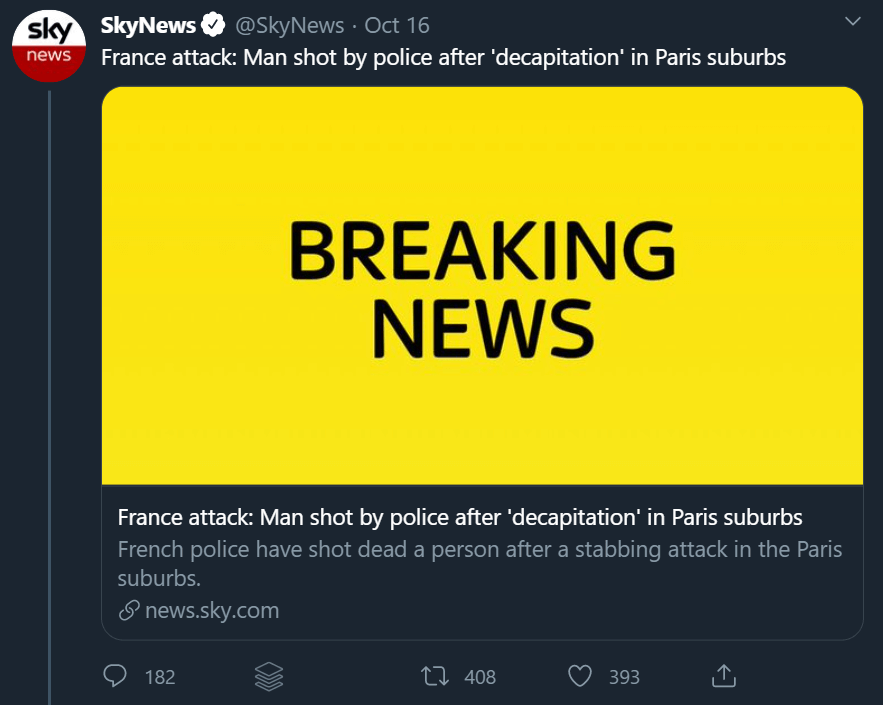Update: 27 October, 2020

It has come to our attention that, after the concerted efforts of HonestReporting and others, the New York Times has revised the headline for the second time. The latest version is far better: “Man Beheads Teacher on the Street in France and Is Killed by Police.“
_______________
When a Muslim extremist yelling “Allahu akhbar” beheaded French schoolteacher Samuel Paty for showing a drawing of Mohammad during a lesson on free speech, the story should only have been framed in one way: This was an unspeakable horror, an act of horrendous violence deserving of the public’s attention.
But instead, the New York Times’ headline was “French Police Fatally Shoot and Kill Man after a Fatal Knife Attack on the Street,”
This prompted a furious response on Twitter.
A high school teacher was decapitated for blasphemy in France—the most secular of nations—and the @nytimes frames it like this pic.twitter.com/xnxJKGNfiE
— Claire Lehmann ??? (@clairlemon) October 17, 2020
No mention of the beheading. No mention of the religious motivations. These facts, known immediately to observers and the authorities, should have been the main focus of the headline. But, for some unfathomable reason, instead the focus is on the response by French police. In fact, the headline makes it appear as if the attacker was possibly a victim of police violence.
Join the fight for Israel’s fair coverage in the news
Related Reading: Why Headlines Matter
For years, Israelis and Jews around the world have cried foul over blatant misreporting of the Arab-Israeli conflict. But all-too-often, such protestations have been countered with disingenuous claims that we are too oversensitive.
So it was interesting to note how the NYT other media outlets managed to shift the emphasis from attacker and motive to an eminently predictable outcome.
The New York Times’ headline was later changed, but it remains problematic: “French Police Fatally Shoot Man who Beheaded Teacher on the Street.”
Again, the Times manages to invert action and consequence, leaving out the identity of the perpetrator and thus leaving many readers in the dark as to the true nature of the attack. This wasn’t a gangland shooting or a police arrest that went wrong after a knife attack, but, unfortunately, the latest in a series of Islamist attacks in France. Readers should be told as much.
Meanwhile, Sky News also had trouble identifying the assailant in its headline: “Man shot by police after ‘decapitation’ in Paris suburbs.”

Another British news outlet, The Guardian, had a similar take, with a report by foreign correspondent Kim Willsher originally published under the words: “French police shoot man dead after knife attack near school in Paris suburb.”
This headline too found itself the subject of sharp criticism on Twitter:
This headline is grotesque.
Affront to the victim and family
Whitewash of the crime
Camouflage of the Islamist ideology
Political narrative. Not journalism.Reprehensible, @guardian. pic.twitter.com/ASOzxyloWE
— Julie Lenarz (@MsJulieLenarz) October 17, 2020
As a rule, HonestReporting does not hold journalists responsible for the headlines their pieces appear under. This is because headlines are often formulated by editors rather than by the writers themselves. With no way to know for certain who is responsible, the blame therefore can only be pinned on the news outlet as a whole for publishing a misleading or biased headline, rather than a specific journalist.
But in this case a dishonorable mention must be given to Willsher. In an online exchange, she told a Twitter user to, “read the article and not just the headline,” thus ignoring the pointed criticisms raised regarding the headline itself.
Utter rubbish. A teacher has been killed by someone reported to be Islamist terrorist. Inquiry ongoing. None of this has been played down. Do read the article and not just the headline.https://t.co/rAy6r3em3J
— Kim Willsher (@kimwillsher1) October 16, 2020
Willsher consequently defended herself as trying “to report the facts, which means sometimes holding back on information until it can be double checked and confirmed. In doing so, there’s no intention to dissemble or cover anything up, just to make sure it’s fact.”
This much is significant and generally commendable. And Willsher’s reporting was far more informative and balanced than the headline originally suggested.
However, while Willsher was unable to determine for a fact that this was indeed an Islamic terrorist attack, given that it was clear from the outset that police suspected it to be so, the headline should have clearly communicated this.
Calling on readers to read the whole story distracts from the point that headlines can and should be judged separately.


